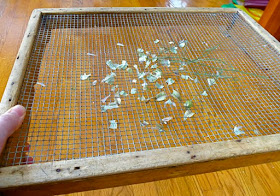This was meant to be a simple project. Just a small bed running alongside the garage to brighten the place up a bit. A place to put an unruly perennial (Plume Poppy - Macleaya cordata) that I couldn't find space for otherwise.
 |
| This large perennial was the instigation for this bed |
 |
| Plants beginning to grow in early 2011 |
By the end of the first season the hollyhocks were completely overtaken with rust and had to be pulled. After two season the hostas are still alive but I'm seriously unimpressed with their appearance. In June their blue green leaves are gorgeous but it's a temporary thing. By August their leaves are yellow and ragged.
 |
| By mid-summer the leaves have turned yellow and brown spots have appeared |
I think this spot is simply too hot for them. The hot sun of late summer burns their leaves and sucks all the moisture out of the soil.
So two of the three plants that initially anchored this bed are no longer feasible. Which meant that this past season I spent some time trying to remedy this hot mess of a bed.
Lupines originating elsewhere in the garden self seeded here and I let them be.
 |
| Lupines growing in another garden area made their way to the garage |
But there's still some room in this bed and lupines are an early season plant. So I have spent some time considering other additions.
I tried an annual grass to see if that might work.
 |
| Purple Fountain grass next to the Plume Poppy |
I also tried adding gladiola.
I took a chance on a bloom called Laguna. The description was a chartreuse flower with a maroon eye. The maroon eye didn't appear on my flowers and the chartreuse colour with this combination did not look right at all. Not to mention the glads didn't seem to get enough sun. They flopped over reaching for the light and took forever to bloom.
Two strike outs.
One of the problems is that everything seems so small next to the Plume Poppy. I think it topped out around 8 - 10 feet by the end of the summer. So in exasperation I bought something that stays tall and doesn't care about light requirements.
This trellis, complete with sweet little birdies, adds a bit of much needed balance to the equation.
So after a season of experiments, what lays in wait next year?
Well, I'm thinking of moving my Martagon lilies here. They are currently residing in the veggie patch so that would free up some space and their red blooms would add a nice pop of colour.
And instead of an expensive annual grass perhaps some cheap seed. Purple beans in fact. I have some seed tucked away and I like the idea of big bean leaves with beautiful purple blooms in mid-summer. They can even clamber up my new trellis.
We'll have to wait until next summer to find out how the next experiment goes.













































